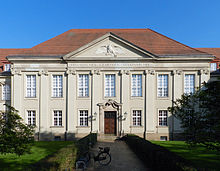General-Ober-Finanz-War- und Domainen -dirium
The General Directorate , actually with its full name General-Ober-Finanz-Kriegs- und Domainen-Directorium, was a Prussian central authority for internal and financial administration that existed between 1723 and 1808 . It was founded by Friedrich Wilhelm I (1688–1740, King from 1713) as a "registry". From this the Secret Ministerial Archives developed, which were merged with the Secret State Archives in 1874.
history
The General Directorate was founded by King Friedrich Wilhelm I set up on 20 December 1722 by arranging the connection of the 1713 founded General Finance Board and the existing since the mid-17th century General (war) Commissioner for General-Ober-financial war and Domain Directory . This new central authority was initially divided into four “departments”, each of which was responsible for several territories of the entire state. From 1740, under King Frederick II, a number of new departments were arranged, which were now structured according to subject areas, namely for trade and manufacturing (1740), for military economics (1746), for excise and customs (1766), for mines and smelters (1768 ) and for forests (1770). Since the provincial departments remained, a complex juxtaposition of responsibilities arose. At the head of each department was a "conducting minister". It was also confusing that Frederick the Great did not submit the “Sovereign Duchy” of Silesia , conquered in 1741/63, to the jurisdiction of the General Directory, but to a provincial minister reporting directly to him. The shortcomings of this organization were recognized by the successors of Friedrich, but only partially corrected. It was only in the course of the Stein-Hardenberg reforms that the general directorate was abolished in 1808 and its tasks were transferred to the modern state ministry , in which the division of responsibilities was structured solely according to subject areas.
Financial, economic and domestic policy (with the exception of the judiciary and the church system) was entrusted to the General Directorate; the war and domain chambers formed in the provinces and most of the special administrations were also subordinate to him .
The individual competencies of this General Management Board include:
(from 1722/1723)
(from 1740)
- Trade and Manufactories
(from 1766)
(from 1768)
(from 1770)
The files of the General Directorate are now in the Secret State Archive of Prussian Cultural Heritage (GStA PK) in Berlin-Dahlem , where they mainly form the files of the 2nd main department:
II.HA General Directory (1723–1808)
- Section 1: Secret Court Chamber and General War Commissariat
- Section 2: Disability and Disability Fund items
- Dept. 3: General Department
- Section 4: General Treasury Items
- Dept. 5: General Financial Control
- Section 6 I: Prussian directorate registry
- Section 6 II: Prussian Ministerial Register
- Section 7: East Prussia and Lithuania (see Lithuania Minor )
- 1. Appointment matters, 1723–1806
- 2. Matters. Titles 1–157
- 3. Office things and office leasing things
- 4. City matters, 1698–1806
- Dept. 8: Lords of Serrey and Tauroggen
- Dept. 9: West Prussia and Network District
- 1. Purchase, cash, budget items, 1772–1806
- 2. Matters. Titles 1-133
- 3. Office things and office leasing things
- 4. City matters, 1772–1806
- Dept. 10: South Prussia
- Dept. 11: New East Prussia
- Dept. 12: Pomerania
- 1. Order matters, 1689–1806,
- 2. Office things and office leases, 1617–1809
- 3. City affairs, 1693–1811
- 4. Matters, 1522-1812
- Dept. 13: Neumark ( Brandenburg )
- Dept. 13a: Brenkenhoff's improvement things etc. ( Pomerania , Neumark )
- Dept. 13b: Brenkenhoff's amelioration matters etc. ( network district )
- Dept. 14: Kurmark ( Brandenburg )
- Dept. 15: Magdeburg
- Section 16: Halberstadt
- Section 17: Minden and Ravensberg
- Dept. 18: Cleve
- Dept. 19: Mark
- Dept. 20: Tecklenburg and Lingen
- Section 21: East Frisia
- Dept. 22: Moers . Funds . Kreuznach goods. Dutch goods, including Grafschaft Geyer . Neufchatel ( Canton of Neuchâtel ). Hanover .
- Dept. 23: Coin Department
- Dept. 24: General Excise and Customs Department.
- Dept. 25: Factory Department.
- Dept. 26: Manufactory and Commerce College.
- Dept. 27: Technical Deputation.
- Dept. 28: silk building materials.
- Dept. 29: Tobacco Matters.
- Dept. 30 I: Oberbaudepartement or Technical Oberbaudeputation .
- Dept. 30 II: Bauakademie-Deputation or Academic Oberbaudeputation
- Dept. 31: Mountain and Hut Department.
- Dept. 32: Salt Department or General Salt Administration.
- Dept. 33: Forestry Department.
- Dept. 34: Military Department.
Independently of Berlin, there was the Silesian General Directory in Breslau, 1742-1808, which was represented by a provincial minister .
literature
- Ludwig von Rönne , The State Law of the Prussian Monarchy , Volume 2, S.31ff
- Friedrich Christoph Förster , Friedrich Wilhelm I King of Prussia , p.173ff
- Karl Heinrich Siegfried Rödenbeck, contributions to the enrichment and explanation of the life descriptions of Friedrich Wilhelm I and Frederick the Great, Kings of Prussia , p.27f on the subdivision
Web links
- Instructions from King Friedrich Wilhelm I in Prussia for the »General Directorate« he newly founded in December 1722 (PDF) Historical Commission of Berlin eV

